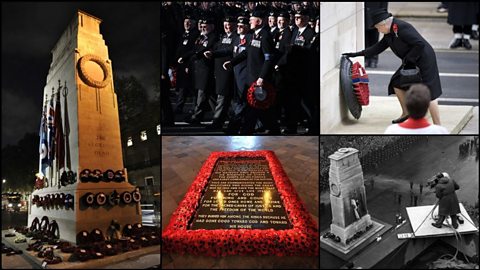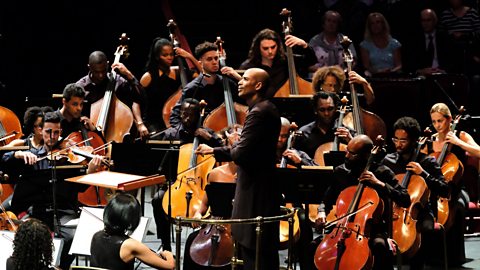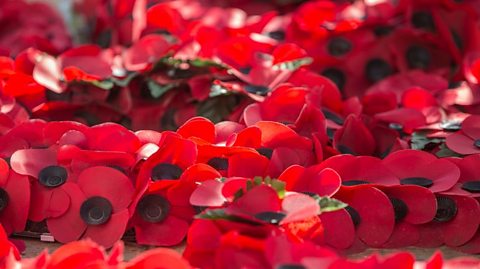At 11am on the 11th day of the 11th month, the UK falls silent for two minutes to remember those who have died in wars worldwide.
Known as Remembrance Day or Armistice Day, it marks the time and day that World War One ended in 1918. A silence may also be observed on Remembrance Sunday, on the second Sunday in November each year.
Music plays a hugely significant role in memorials and services right across the country, with military and civilian bands often in attendance.
±«Óătv Bitesize has taken a look at the history and meaning of some of the music you’re likely to hear around Remembrance Day.
The Last Post
The sight and sound of a lone bugler playing the Last Post will be a familiar one. This mournful tune is played at Remembrance Day events and services across the The Commonwealth was set up in 1926 between Britain and all partly independent countries in the empire, which were also known as dominion states. Eventually other territories within the empire became part of the Commonwealth., as well as military funerals.
Originally, the Last Post had a purely functional role. Prior to wristwatches becoming widely available, the British Army needed a way of guiding soldiers through their daily schedule. This was done through bugle calls. Towards the end of the day, the First Post was sounded to signify that the duty officer was beginning their final rounds, checking the sentry-posts. The Last Post would then sound when the round was complete and the last post inspected.
From the mid-19th Century, the Last Post was increasingly played at the funerals of soldiers who had died overseas, where there were no military bands to provide music. Over time, the sound of the Last Post took on greater meaning, coming to symbolise the end of life as well as the end of the day. Following the Boer War, it was played at the unveiling of new war memorials and it became an act of remembrance.
At 8pm every evening, the Last Post can be heard at the Menin Gate Memorial to the Missing in Ypres (Ieper), Belgium. Whatever the weather, police close the road and stop traffic whilst the commemoration is observed, in a daily ceremony that stretches back to the late 1920s. The only interruption came during the four years of German occupation from 20 May 1940 to 6 September 1944.
Nimrod
Have you ever wondered why Edward Elgar named this composition Nimrod? It’s actually a tribute to a close friend of his, Augustus J. Jaeger. In the Bible’s Book of Genesis, there is a great hunter warrior figure called Nimrod. Translated into German, hunter becomes jäger.
Nimrod is just one section of a 14-part piece of music known as the Enigma Variations, or more formally, Variations on an Original Theme (“Engima”), Op.36. Each piece was inspired by one of Elgar’s friends or family, identified through their initials or a form of disguise, like above.
Performed ever year at the National Service of Remembrance at the Cenotaph in London’s Whitehall, Nimrod is often played on significant national occasions. For example, it was played at the funerals of both Diana, Princess of Wales in 1997 and Prince Philip, Duke of Edinburgh in 2021, as well as the London 2012 Olympics Opening Ceremony.
I Vow To Thee, My Country
A staple of the annual Festival of Remembrance at the Royal Albert Hall, I Vow To Thee, My Country is one of Britain’s most popular hymns.
It started life as a poem, written in 1908 and then revised during World War One by Sir Cecil Spring Rice, who was the British ambassador to the United States at the time. If the tune sounds familiar, that’s because it’s actually set to the music of Gustav Holst’s Jupiter, the fourth movement of The Planets suite. Holst had to lengthen his music to accommodate the full length of the poem, and add a harmony.
At her request, I Vow To Thee, My Country was sung at the wedding of Diana, Princess of Wales and the then Prince Charles in 1981. It was also performed at the funerals of Winston Churchill, Margaret Thatcher and Captain Sir Tom Moore.
Flowers of the Forest
Also known simply as The Lament, this Scottish folk tune is traditionally played by a lone bagpiper at funerals and memorial services. However, at the National Service of Remembrance it is performed by a group of bagpipers.
Flowers of the Forest is thought to commemorate the defeat of the Scottish army at the Battle of Flodden in 1513, during which King James IV of Scotland was killed.
The earliest record we have of the melody is from the John Skene of Halyards Manuscript, published in around 1615-1625. But over the years, different lyrics have been sung to the music, including versions by the Scottish poets Jean Elliot and Alison Cockburn.
Men of Harlech
Hugely important to Welsh culture and national pride, Men of Harlech can often be heard at sporting events and similar occasions, sung in either Welsh or English. It is used as a regimental march by Welsh regiments within the British Army, and at the National Service of Remembrance it is played towards the start of the ceremony.
It is not entirely clear which historical event the song commemorates. During the Wars of the Roses, Harlech Castle was held by the Lancastrians for seven years as it came under intermittent attack. It finally fell in 1468 but the struggle may have been immortalised in Men of Harlech.
Alternatively, it could be linked to Welsh hero Owain Glyndŵr, who successfully seized the castle in 1404 and set up court there.
This article was published in November 2022.
The Cenotaph, The Unknown Warrior, the Royal British Legion and more

Classical music is everywhere in pop culture if you look hard enough.

Quiz: Remembrance Day in numbers
How much do you know about WW1 and Remembrance day?
